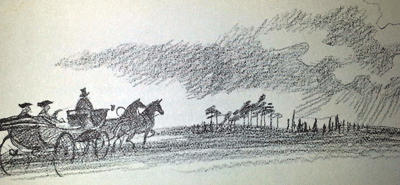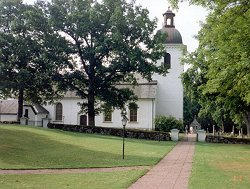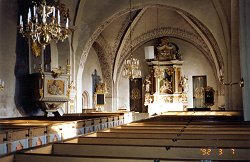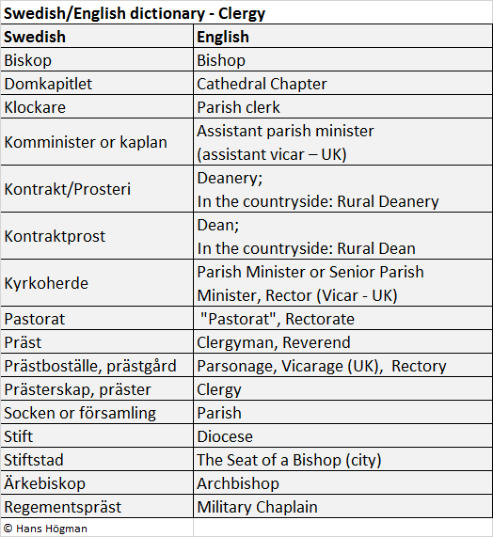

Copyright © Hans Högman 2018-04-29


The History of Church of Sweden
- A Lutheran Church
Before the Reformation engulfed northern
Europe, Sweden was a Roman Catholic nation like
most countries in Europe. In 1517 the German
theologian Martin Luther (1483 - 1546) initiated
the Reformation which divided the Roman Catholic
Church. The division resulted in a Protestant
Church movement dominated by Martin Luther's
followers who came to be called Lutherans and
their church became the Lutheran Church.
In Sweden, King Gustav
Vasa, who reigned
between 1523 and 1560,
was facing large war
debts and needed money
after the Swedish
Liberation War which
defeated the occupying
Danes.
Gustav Vasa saw the Reformation as a unique
opportunity to rid of the Crown's debts.
At the parliamentary meeting in Västerås in 1527,
he proclaimed Sweden a Protestant nation with a
Lutheran Church. In the following years the King
broke with the Pope by appointing bishops and an
archbishop.
At the parliament meeting in Västerås in 1544,
Sweden proclaimed an evangelical kingdom with
the King as Head of the Church. Gustav Vasa was
now in a position to gain the wealth that had
previously been going to the Roman Catholic
Church along with the Church lands and other
properties. The power of the monarchy also
extended to the Church, and the Sovereign was
responsible to ensure that God's law applied to the
realm.
It was mainly the countries in northern Europe that
converted to the Protestant Church.
That is how Church of Sweden became a State
Church and the clergymen/reverends became
government employees.
The first church law
after the Reformation
was adopted in 1686
under the reign of
King Karl XI. It defined
Sweden as an
evangelical nation and required Swedes to confess
the evangelical faith.
The Roman Catholic Church was banned in
Sweden. Swedish citizens would be sentenced to
death if they belonged to a faith other than the
State Lutheran Church (Church of Sweden).
Foreigners with business in the realm, who wanted
to practice another form of Christianity, or another
faith, were obliged to worship in their homes,
behind closed doors, and in privacy.
The church law of 1686, also stated that the Church
must keep official church records on its
parishioners. These official church records included
births, baptism, marriages and deaths.
The King, as Head of the Church, used the church
records to gain control of all the inhabitants in the
country and for example, made it easier to enlist
soldiers by involuntary conscription (utskrivning).
These Church records have become a "gold mine"
for the genealogists!
The Church Organization
Introduction
When you are doing genealogical research of
ancestors in Sweden, you probably need to browse
through the Swedish church records. Therefore, it
should be interesting for genealogy researchers to
know how the Swedish Lutheran Church has been
organized over the years. Not only that, you can
gain a better understanding of some of the
terminology you will find in the Swedish church
records. Even if you do not understand Swedish,
knowing the church terminology will help you to
find important information about your ancestors.
The Historical Church Organization
Before modern times the Church of Sweden was
organized from the highest levels to the lowest as
follows:
•
Church Division / Subdivision
Leader's
Title
•
Bishop of Uppsala
Archbishop
(Head of the Church)
•
Stift (Diocese)
Bishop
•
Kontrakt/Prosteri (Deanery)
Kontraktsprost (Dean)
•
Pastorat (District)
Kyrkoherde
(Parish Minister/Reverend. [Vicar UK])
•
Socken (a parish's territory)
Komminister/Kaplan (Assistant Parish
Minister/Rector)
In order to better explain how Church of Sweden
functioned and how it operates today, it seems
more helpful to provide further explanations of the
various subdivisions in reverse order. This way the
reader will better understand how each level
supported the next level up.
The Socken
There were two types of "socken".
The Swedish subdivision into "socken" is very old
and dates from 12th or the 13th century.
”Socken” has two meanings and it is not known
which meaning was used first.
•
Religious (church) - A geographical area served
by a church, an ecclesiastical unit. In other words
this is a parish. When we speak of the "socken"
today we only mean the religious "socken".
•
Worldly (secular) - A geographical area for local
administration.
A local administration council (sockenstämma)
ran the "socken".
Before 1862, the church "socken" and the
administrative "socken" encompassed the same
territorial area. However, the worldly "socken" was
replaced by an administrative subdivision called
"kommun" (municipality) in that year.
The Church Socken
As explained above a
Church "socken" is the
same thing as a parish.
From now on I will only
refer to "socken" as a
church "socken".
Normally a "socken"
(parish) is a territorial area. However, there are also
non-territorial parishes. The latter is common in
lager cities where the parish is not an area where
all the members of the congregation live, but a
number of people living all over the city.
A Lutheran parish is lead by a "komminister" - an
assistant parish minister (assistant vicar in the UK
or a pastor in the US). The old title for a
"komminister" was "kaplan".
The "komminister" was also the chairman of the
wordly "sockenstämma" mentioned above. The
members of the “sockenstämma” were elected from
the prominent persons in the area. The minister /
assistant minister was as the spiritual leader of the
parish church one of the most prominent person in
the “socken” and therefore a natural chairman of
the council (sockenstämma). This gave the ministers
/ assistant ministers both a spiritual and a secular
role in the society.
In every parish there was also a "klockare" (parish
clerk and organist) helping the "komminister" with
practical matters.
Today there here are about 2,500 parishes in the
Church of Sweden.
The Pastorat
One or several parishes forms a pastorat. The
clergyman in charge of a "pastorat" is a
"kyrkoherde" (Parish Minister (US) – Vicar (UK) -
Reverend).
A “pastorat” (rectorate) is the office or jurisdiction
of a parish minister.
The largest parish within a "pastorat" is called
"moderförsamling" (head parish) and the other
parishes "annexförsamlingar" (annex parishes).
The parish minister is the clergy of the head parish
(moderförsamling) in the pastorat. The minister is
also in charge of the annex parishes in the
"pastorat". Therefore the assistant ministers of the
annex parishes are subordinated the minister.
Historically, there was a large difference between
the different "pastorat". Some smaller" pastorat" in
the countryside could be very poor while others
were located in richer areas.
Of course the ministers in richer areas had a higher
status and it was easier to recruit new ministers to
these areas.
There was also a hierarchical professional distance
between the ministers and the assistant ministers
in the "pastorat". The governing body of the church
was arranged in an hierarchical fashion with each
position subordinate to the position above it. The
Archbishop was the highest church office. The
"komminister" or Assistant Minister was the lowest
office and subordinate to the Senior Minister or
"Kyrkoherde" .
Another type of parish was the parishes of the field
regiments, that is the mobilized regiments. Each
regiment had a regimental chaplain
(Regementspastor) and two assistant chaplains
(bataljonspredikanter). In times of war there
could be several assistant chaplains in a regiment.
When the regiment was at home, the soldiers and
the officers were members of their ordinary home
parishes.
It was normal that castles and larger country
estates formed their own congregations. The
nobility had the right to employ their own pastors.
However, these private parishes had to be
approved by the Cathedral Chapter (Domkapitlet).
The Kontrakt (Deanery)
One larger "pastorat" or several smaller ones forms
a "kontrakt" (Deanery). Another term for "Kontrakt"
is "Prosteri" in Swedish.
Normally a deanery consists of 4 to 8 "pastorat".
The head of a deanery is the "kontraktprost"
(Dean / on the countryside a Rural Dean) and is
appointed by the Bishop.
The Dean is the minister of the largest "pastorat"
within the deanery and in former days the
supervisor of the ministers in that deanery.
The communication between the Cathedral Chapter
and the ministers always went through the Dean.
The following diagram may help to better explain
this church organization:
The Stift (Diocese)
A number of deaneries form the "Stift" (Diocese).
The head of a Diocese is the "biskop" (Bishop).
Today there are 13 dioceses in Sweden.
The seat of the bishop is called "stiftstad" (Diocese
Seat) and in each diocese city there is a cathedral.
Each diocese has is a board called the Cathedral
Chapter.
The bishop of Uppsala is the Archbishop and is
the spiritual leader of the Swedish Lutheran
Church. It is the Archbishop who ordinates the
bishops.
In the old Parliament, the Riksdag
of the Estates (Ståndsriksdagen),
the Clergy was one of the four
Estates.
The Estate of the Clergy consisted
of 50 members. The bishops and
the clergy appointed from every
diocese represented this House.
The image shows Uppsala
Cathedral.
From the end of the medieval times (15th century)
there has been a cathedral school (katedralskola) at
each cathedral with the purpose of training new
clergy. The school has four stages and ends with a
two-year priest seminars (prästseminarium).
The Clergy
Appointments of Parish Ministers
The clergy were given lifetime appointments. When
a clergy (parish minister) had passed away, he was
to be replaced with a new minister.
A new appointment could take some time to
determine and depended on three factors:
1.
If the deceased minister was married
2.
If he was a widower with unmarried daughters
3.
If he was a widower without children
In the first two cases the "nådårstiden" (period of
grace, respite) was applicable. Normally an
employment year was from May 1st to April 30th.
All ministers changing assignments did so on May
1st and the period of time until May 1st was called
"tjänsteåret" (service year). When the service year
came to an end at May 1st, the widow or the
daughters had an extra year, "nådårstiden" (year of
grace), to remain at the parsonage.
The "sockenstämman" of the parish was anxious to
have the widow and daughters provided for during
the year of grace without any costs for the parish.
A way to do that was to get the new minister to take
the appointment as the parish minister with the
terms to provide for the former minister’s wife
and/or daughter. Depending on the age of the new
minister and the age of the widow he could marry
the widow. If the minister was much younger and
there was a daughter of the appropriate age, he
could marry the daughter.
This was called "att konservera prästänkan" (to
preserve the minister's widow).
In this way the widow didn't have to move out of
the parsonage.
This way of handling the problem with the widow
was also common among the soldiers within the
military Allotment System - the successor of the
deceased soldier on the soldier's croft of that "rote"
married the old soldier's widow.
Salaries
The salaries of the clergy did vary a lot between the
different "pastorat" depending on the economy of
the parishes.
The clergy were paid in kind (naturalön) in the form
of 10% of the yield from the farms in the
congregation in country parishes (The Church tenth
- also called a tithe). This tithing system was called
"tionde" in Swedish. This was paid to the minister
in the form of seed, butter, milk, calves, etc. The
clergy also received cash in hand.
If the farmers had a good year, the minister
received more and in a bad year he received less.
The clergy were maintained in a similar way as the
officers of the Military Allotment System - in a
civilian Allotment System.
The parsonage - vicarage (prästboställe)
A church wasn't consecrated until it was completely
finished and when a parsonage (vicarage [UK]) was
built. A parsonage was a house for the parish
minister to live in. On the countryside it was a small
farm.
The parsonage was a part of the parish; the
parsonage and parish church belonged together.
It was the responsibility of the congregation to
build and maintain both the church and the
parsonage. Both the salary and the size of the
parsonage depended on the economy of the
parish.
According to the regulations a parish minister's
house, called the parsonage (prästboställe),
consisted of seven buildings (De sju laga husen).
There were the main living quarters (stuga), the
kitchen (stekhus), the hay barn (lada), the grain
storage bin - granary (kornbod), the storehouse
(visthus), the sleeping quarters (sovstuga) and the
cow barn (fähus).
If the clergy added extra buildings to the parsonage
it was his personal belongings. The successor then
had to buy him out.
Both the salary and the size of the rectory were
depending of the economy of the parish.
The assistant ministers (kaplan) had to settle with a
smaller place to live in (kaplansboställe). Prior to the
1690's they had to provide their own living
quarters. After that time, the parishes provided
their housing.
Herdaminnen (Diocesan Annals)
If you have a clergyman among your ancestors you
have an important source to look at:
“Herdaminnen” (diocesan annals).
The “Herdaminnen” is a detailed presentation of
every clergyman within a diocese from the 1500’s to
the present day. The “Herdaminnen” is published
per diocese, so you have to know which diocese he
served in.
You will find the “herdaminnen” at libraries. I’m sure
that you will find them at the LDSs Family History
Centers as well.
No Freedom of religion in former days
In the mid-1800's there was a large Swedish
emigration due to religious conflicts. But from the
1860's greater freedom of religion was allowed in
Sweden. In 1860 it became possible to withdraw
from the Church of Sweden. However, you could
only withdraw if you had become a member of
another religious community, a community
approved by the state.
Not until 1951 were full religious freedom
guaranteed to everyone by law.
Female Ministers, Church of Sweden
In 1960, two women from the Stockholm Diocese
and one woman from the Härnösand Diocese
became the first female parish ministers to be
ordained by the Church of Sweden.
Before 1958 women didn't have the legal right to
ordination. An Act taken in the Parliament in 1958
changed this. However, there was a clause in the
Act (the so-called Clause of Conscience), which gave
bishops the right to refuse ordinations of women if
they thought it was against their personal believes.
The clause also made it possible for ministers to
refuse to work with female ministers if they felt it
was against their conviction.
This made it impossible for women to be ordained
in dioceses where there was an opposition against
female ministers and to get an employment in
parishes where there was a minister that didn't
believe in female ministers.
In 1982 the Act of 1958, which gave women the
right to be ordained, was abolished.
It was replaced with the Act of Equality of
opportunity between men and women and it also
applied to the Church of Sweden. Thereby no
bishops or minister could refer to the old Clause of
Conscience any more.
According the Church Order of the year 2000, every
minister that applies for an employment within the
Church of Sweden has to declare the he/she is
prepared to work with ministers of the opposite
sex.
The first female bishop in Sweden was appointed
in the Lund diocese in 1997.
During the last few years (2002) there has been
more female theology students than men. In 2001
about a third of all ministers were women. During
the last years there has been a larger number of
theology students being women then men. In
January 2002 about 66 % of all the students were
women.
The Roman Catholic Church and the Orthodox
Church still refuses to ordain women. All the Nordic
countries have female ministers; Denmark from
1948, Sweden from 1960, Norway from 1961 and
Finland from 1988.
The first women in the US Anglican Church were
ordained in 1974. In the UK, Church of England
didn't give women access to ordination until 1992.
The Jewish Reform Movement began ordaining
female rabbis in 1972 and the Conservative Jewish
Movement did the same in 1985.
Church and State today
On 1 January 2000 a separation of church and
state was enacted in Sweden. On that day, the
Church of Sweden legally became a ”faith-
community” which, along with others like the free
churches, Roman Catholics, Jews, Moslems etc,
could now register themselves as such with the
state. Their church dues can then be collected by
the state along with income tax.
The fee the members of the Church of Sweden pay
to the church finances about 80 percent of church
activities.
Dictionary
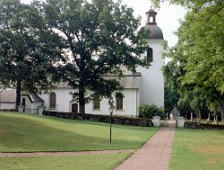
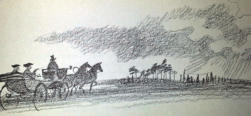
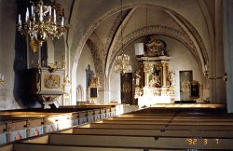

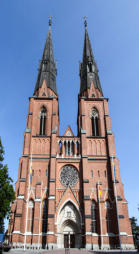
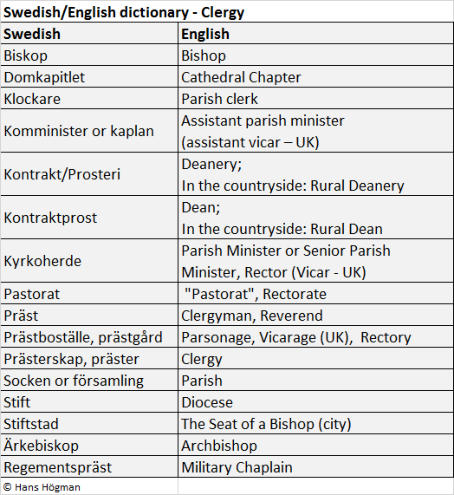
The History and
Organization of
Church of Sweden
Source Reference
•
Södermanlands kyrkliga struktur under 1600-
talet av Ragnar Norrman, en inlaga i "Kyrka och
Krona i Södermanländskt 1600-tal", utgiven av
Mörner, Mariefred.
•
Swedish National Encyclopaedia, NE
•
Church of Sweden
Top of page








